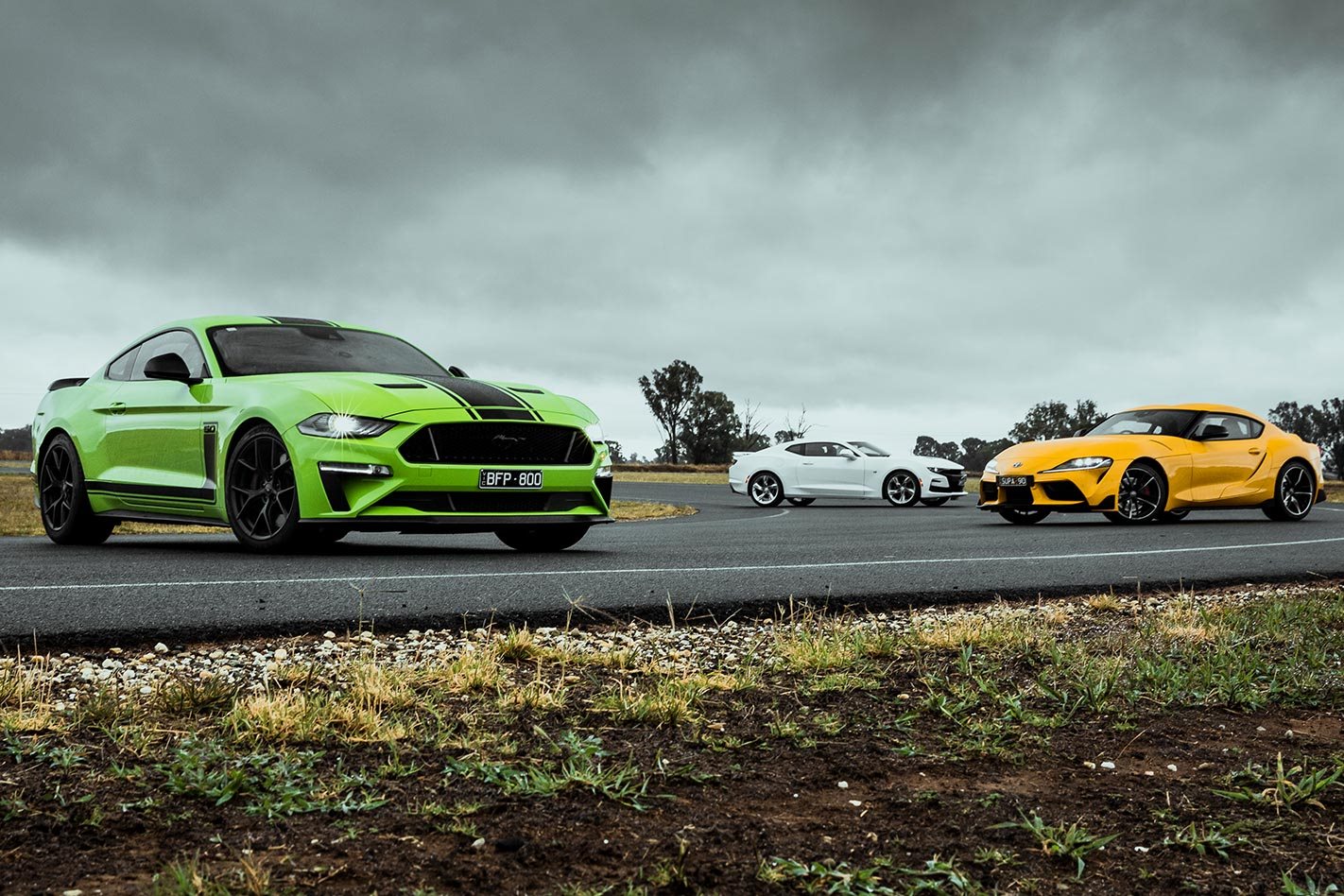Australia’s car culture was built on muscle cars. Ever since the XR Falcon GT finished one-two at the 1967 Bathurst 500, bestowing the beautiful gold road cars with a winning pedigree, Aussie enthusiasts have voted with their wallets.
We want powerful, rear-drive performance cars, preferably with eight cylinders under the bonnet. This lust lasted as long as it could, until Ford, then Holden, then HSV wrote their respective final chapters in the book of Australian manufacturing.
The departure of our homegrown heroes left a huge hole in the motoring landscape, but thankfully the rest of the world has stepped in to at least partially fill the void – America, principally, given its similar proclivity for high-powered rear-drivers. Ford was first into the fray with the Mustang and boy did it reap the rewards, the iconic pony car proving more popular with Aussies than toilet paper in a pandemic.

More than 26,000 Mustangs have been sold here at the time of writing, making it far and away Australia’s favourite performance car. Not one to sit idle, HSV began converting the Mustang’s arch-nemesis, the Chevrolet Camaro, to right-hand drive in 2018. The blue versus red rivalry would continue, albeit with fewer doors. Camaro hasn’t enjoyed anything like the popularity of its Detroit neighbour, selling around 1500 units, but it’s been a welcome addition to the market.
The final participant in this muscle car flex-off might raise a few eyebrows, but it shouldn’t. In standard guise, the Toyota Supra has always been basically a Japanese interpretation of a muscle car; the latest iteration has slimmed down and sharpened up, but it still adheres to the same recipe: plenty of grunt, rear-wheel drive and a focus on everyday usability over the lowest possible lap time. To anyone wanting to play the “it’s not a V8” card, let me just say the following: Torana GTR XU-1, Charger E49, VL Turbo, XR6 Turbo.
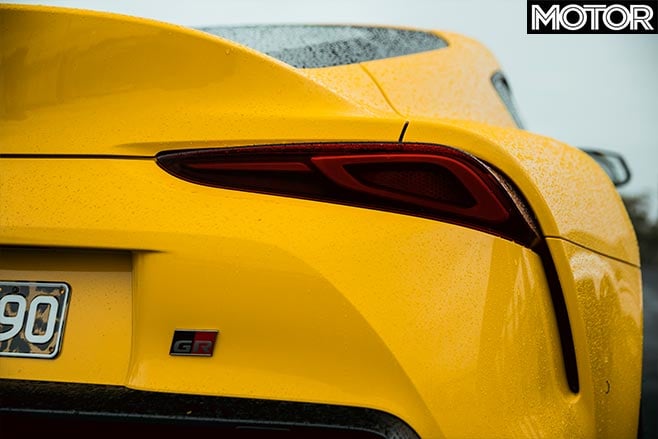
The Supra is a little outgunned on paper, though; its 3.0-litre straight-six is boosted by a turbocharger but musters only 250kW/500Nm. At 1495kg it has the least weight to move, but its power-to-weight ratio of 167kW/tonne looks a little lean compared to its competitors. The Camaro has literally twice the engine and then some, its brawny 6.2-litre LT1 V8 producing 339kW/617Nm and 196kW/tonne.
But the Mustang R-Spec sneers at such figures with disdain. A supercharger nestled atop the otherwise standard 5.0-litre V8 boosts outputs to 522kW/827Nm, or 293kW/tonne, which slots it between the Mercedes-AMG GT R (277kW/tonne) and Aston Martin DBS Superleggera (315kW/tonne). Impressive company for a car that costs just $99,980, though that’s well north of the Supra ($94,900) and Camaro ($86,990 as a six-speed manual).
It’s also a $36,290 premium over the manual Mustang GT that every R-Spec starts life as. So what do you get for the extra outlay? It’s pleasing to note Ford didn’t just install the supercharger and call it a day; there is more to the R-Spec than the extra power.
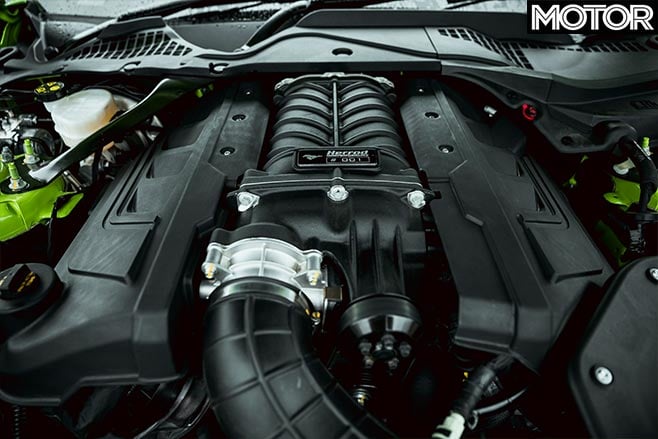
The Ford Performance supercharger kit is naturally the main attraction, consisting of a Roush R2650 blower, 87mm electronic throttle body, air intake system and fuel rails, as well as a new exhaust. The chassis benefits from wheels a half-inch wider than standard (9.5-inch front; 10.0-inch rear), new progressive-rate springs that drop the ride height 20mm, adjustable anti-roll bars and a recalibration of the MagneRide adaptive suspension.
The latter modification is an unexpected highlight of the R-Spec, for it rides beautifully. The suspension feels better than standard, remarkable given that the ride height drop and stretched tyres (the wider wheels wear the regular Michelin Pilot Sport 4S tyres 255/40 front, 275/40 rear) would suggest a compromise. In addition to the light clutch and gearshift, and smooth, tractable engine, it makes the R-Spec an excellent everyday proposition. It’s a really enjoyable car to drive without even dipping into that 700-horsepower well.
More so than the Camaro. The Chev’s gearbox isn’t as slick, the steering requires more effort, it’s harder to see out of and, bereft of the Magnetic Ride Control available as an option in the US, the ride isn’t as settled.
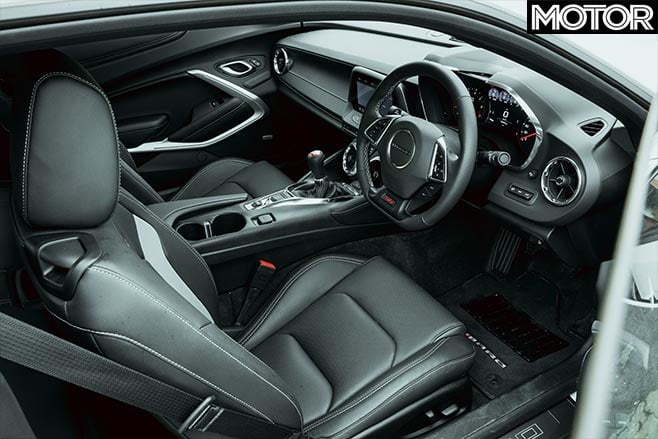
It’s not bad by any means, but you’re aware of imperfections in the road that don’t ruffle the Mustang. In manual guise, both cars are hampered by the right-hook conversion; neither Ford nor HSV flip the centre console, making gearchanges difficult if there’s any sort of beverage in the cupholders. A slight but frequent annoyance.
No such drama in the Toyota, as it’s only available as an eight-speed automatic. The Supra sits neatly between the two Americans in terms of ride comfort; it’s a little more reactive than the Mustang but there’s a surprising level of compliance. The biggest day-to-day hurdle is getting in and out of it – care must be taken not to hit your head on the roof sill – and getting comfortable once seated, as it’s a fairly cosy environment. Larger folks may struggle.
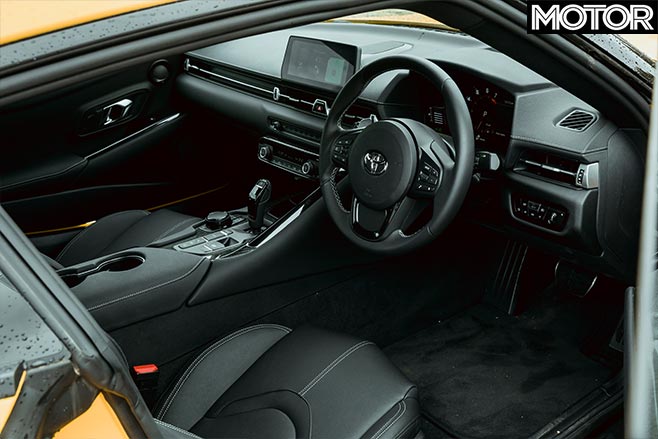
Our initial experience of the R-Spec last issue was tainted. To get Ford’s full five-year warranty, the ECU is somewhat of a helicopter parent, constantly buzzing around looking for signs of trouble. If the fuel quality is a little off or temperatures a bit high, it will quickly and dramatically reduce power – good for peace of mind, bad for performance. With the mercury reading north of 30C, by the time we conquered the R-Spec’s launch difficulties – it’s a right pain to get off the line – we were dealing with perhaps 400kW and a best quarter-mile time of 12.78sec at 189.47km/h, not at all representative of its potential.
It appears MOTOR is doomed not to extract the R-Spec’s potential, as today’s forecast projects heavy rain. If that’s not enough, the clutch is slipping under full throttle; no slight on the car, as this particular example has been performance-tested by at least four media outlets and completed a number of track tests, probably equivalent to 20 years of regular driving. Thankfully, both the weather and the clutch hang on long enough to record 0-100km/h in 4.59sec and a storming 12.30sec quarter mile at 195.24km/h. Much better.
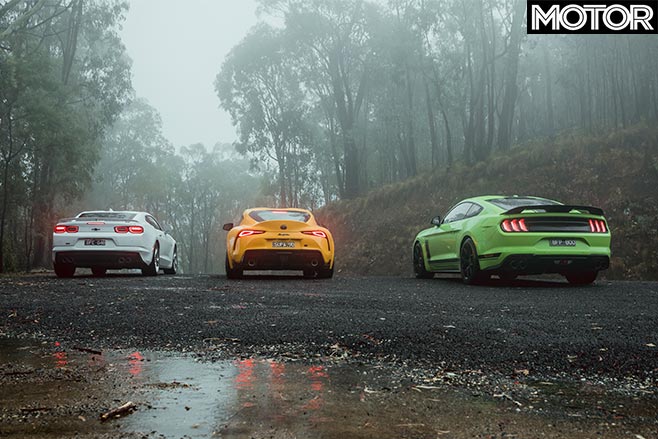
Yet nothing about the R-Spec is optimised for the drag strip; despite torque being limited in the first two gears, it will happily blow the rear tyres off if you’re clumsy with the throttle, the gearbox doesn’t like to be rushed, and the gearing couldn’t be worse. On a good run the trap speed will vary between 196-198km/h, but third gear runs out at 194km/h, forcing a time-sapping shift to fourth. Nevertheless, 4.4 and 12.1sec feels possible and high-11s are there for the taking using drag strip timing (one-foot rollout).
To be honest, it’s Mustang first, daylight second. Its superiority is illustrated in a brutal 1.8sec 80-120km/h time, a figure more commonly associated with the likes of BMW M5 or Porsche 911 Turbo. The Camaro, likewise in second gear, takes 2.7sec to cover the same increment and the Supra 2.6sec in Drive. Knock the Mustang into third and it’s still quicker (2.4sec) than the others at their optimum.
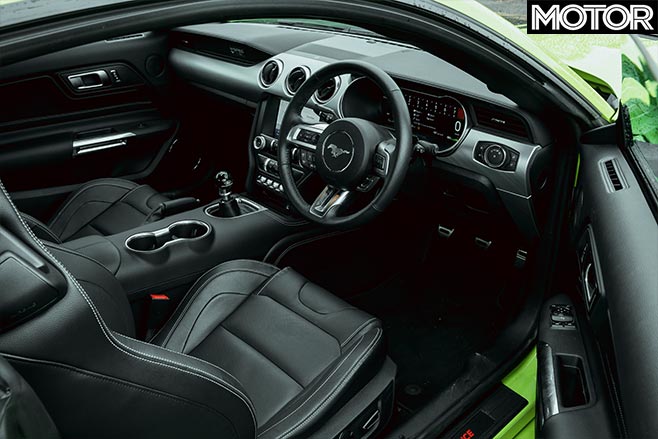
Full disclosure, though: the immediate arrival of rain means the Camaro and Supra numbers are from different days at different locations, but all three are representative figures recorded in similar conditions. The Toyota is simultaneously the quickest and the slowest car here, as impossible as that sounds. Launched with slight wheelspin, it’s the first to 100km/h (4.44sec) but from there its relative lack of power shows as the V8s either gradually (Camaro) or quickly (Mustang) reel it in, crossing the quarter mile in 12.62sec at 181.16km/h. It will be interesting to see the effect the recently announced updated Supra’s 285kW affects these numbers.
An automatic Camaro 2SS would knock off the Supra on the strip, but the manual is slightly slower. It’s not particularly difficult to launch and 0-100km/h in 4.7sec and 12.8sec at 182.1km/h for the 400m isn’t shabby. The LT1’s punch is dulled by extremely long gearing; first runs to 87km/h, second 129km/h and third 177km/h. Like the Mustang, a frustrating shift to fourth is required just prior to the quarter mile line.
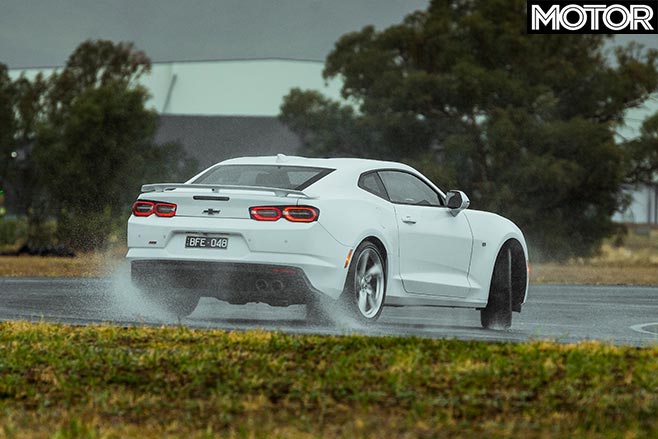
Of far more relevance is the effect the gearing has on real-world driving. The math is easy enough: in a country where 110km/h speed limits prevail, you can effectively enjoy the Camaro until 5500rpm in second gear. While Australia’s hatred of speed isn’t Chevrolet’s problem, when such limits are fairly common worldwide (including in the US) and a key part of the enjoyment of a manual muscle car is changing gears, choosing gearing that effectively denies the driver the opportunity to do so feels odd. The good news is that the Camaro’s V8 has a fat mid-range, doing its best work by 6000rpm at the most, so short-shifting doesn’t impede progress.
There’s much more to enjoy in the Chevrolet than just the engine, though. Anyone who’s driven a performance Holden of the past 10-15 years in anger will recognise the way the Camaro goes about its business. Steering aside, that is. The tiller is excessively weighty in Tour mode and only gets heavier from there, but you can lock in the lightest setting and it gets better with familiarity.
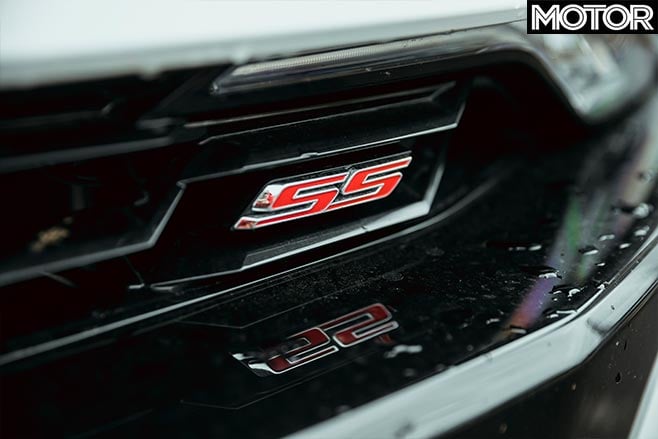
There’s never a worry about driving the Camaro quickly, even as torrential rain continues to hammer down. The Competitive Mode ESP is brilliantly judged but also rarely troubled, as any grip loss usually happens progressively and is telegraphed clearly. With the electronics banished, the Camaro displays fantastic balance; there’s a great chassis here, and the ride even smooths out as speeds increase.
Even with its suspension upgrades, the R-Spec isn’t as dynamic. Make no mistake, it’s still a capable, enjoyable performance car in the corners, but there isn’t enough feedback. On the plus side, it’s remarkable how much power can be deployed on a slippery surface, but that’s more a tribute to the smoothness of the power delivery.
A trait inherent in every Mustang is that once the lateral purchase of the tyres is exceeded grip levels fall off a cliff; the Michelin Pilot Sport 4 S tyres that arrived with the MY18 update mitigate the effects slightly (the old Pirellis were diabolical in the wet), but it can still be a snappy beast. Like the Camaro’s Competitive Mode, the Mustang’s Track ESP is extremely well-judged, but disengage it and opposite lock has to be applied extremely quickly to avoid an embarrassing spin.
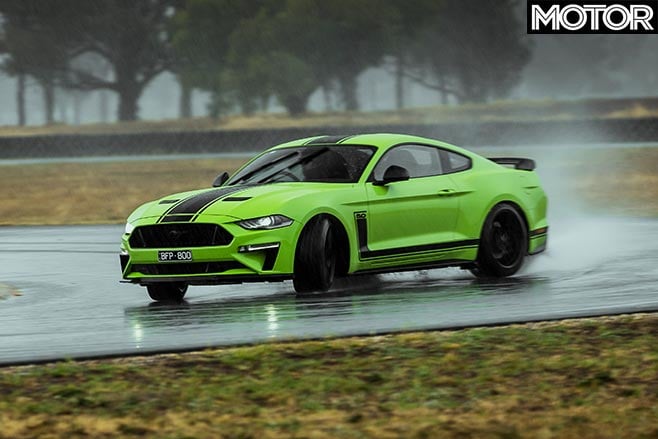
Another similarity between the Camaro and the Mustang is ludicrous gear ratios. As a consequence of its higher rev ceiling – 7400rpm vs 6500rpm – the Ford stretches even further between changes. It’s less of an issue than in the standard ’Stang, as the R-Spec undoubtedly has the grunt to pull the gearing, but imagine what a rocket it would be with a shorter diff!
There is an appeal to selecting third, flooring the throttle and feeling the power build and build and build all the way to almost 200km/h, but it’s a thrill you’re never going to feel on the public road. It’s a great gearshift, albeit one you will rarely touch on a twisty bit of tarmac (or even on the track).
Toyota Supra: Facts you might not know
The Supra almost has the opposite issue. With such a broad spread of torque, two or three of its eight closely stacked gears are probably redundant. Ironically, the exception is the super-short second, available only to 78km/h; it’s the gear you often want in tight corners, but the large gap to third often leaves the downshift paddle being clicked ineffectually. It’s one of few complaints. In outright ability the Supra is clearly the best car here because of, well, physics. It’s nearly 250kg lighter than the Camaro and 300kg lighter than the Mustang yet has a similar footprint, so little wonder it hangs on when the others have let go.

Strong brakes and great steering are further Supra attributes, though on a wet track it has a tendency to abruptly fall into oversteer, particularly if you trail the brakes on corner entry. Outright grip disguises this in the dry, but it can be a handful if you’re not expecting it. The only other issue is the slightly soft top-end power delivery, but presumably this will be rectified once the 285kW tune arrives. At any circuit with more corners than straights, it’s almost certain the Supra would be the quickest despite its power disadvantage.
But do muscle car buyers care about lap times? If the criteria is putting a smile on your face then the Supra falls short because, for all its excellence, it’s a serious car. Driving it very hard isn’t the only way to enjoy it, but it’s how it gives its best and, while it’s perfectly capable of cruising, it doesn’t necessarily remind you that you’re in something special while doing so. It’s unfair to criticise a car for being too polished, so we won’t, but while the Toyota adheres to the muscle car recipe in terms of ingredients, it doesn’t have the right seasoning when it comes to attitude.
The R-Spec takes on the Supercharged Camaro ZL1
The Mustang R-Spec certainly does. It looks great, makes a good noise (though is better outside than in) and has a simply immense amount of grunt in the right circumstances. For many, the $100K-equals-522kW equation will be enough; the fact the R-Spec is such an enjoyable road car is icing on the supercharged cake. But its limitations are its downfall. Some of those are inherited from the base car, but the gearing and the way it develops its power means opportunities to exploit its performance are few and far between on the road.

There’s always the track of course, and on a cool-to-mild day the Friday night drags or some short-circuit sprint sessions should be no problem. Simply creating the R-Spec was an amazing achievement and the end result is credit to those involved, but in offering a warrantable supercharged Mustang, Ford has created a beautiful sword then blunted the edge to make it less dangerous. Still a lovely object, but not quite as exciting.
Simply put, of this trio, the car that is the most enjoyable across all disciplines is the Chevrolet. There’s an element of ‘jack of all trades, master of none’ at play here; it’s not the sharpest or the quickest or the most comfortable, but it is the most fun.
Whether you’re squirming away from the traffic lights, blasting through corners on a mountain road or belting the hell out of it on-track, the Camaro always makes you grin. It’s an honest, uncomplicated car with a sense of humour and the closest thing we have, in concept and execution, to our former Aussie heroes.

Fast Facts
u00a0 | Ford Mustang R-Spec | Chevrolet Camaro 2SS | Toyota Supra GTS |
Body | 2-door, 2+2-seat coupe | 2-door, 2-seat coupe | |
Drive | Rear-wheel | ||
Engine | 5038cc V8, DOHC, 32v, supercharged | 6162cc V8, OHV, 16v | 2998cc inline-6, DOHC, 24v, turbocharged |
Bore x Stroke | 93.0 x 92.7mm | 103.25 x 92.0mm | 82.0 x 94.6mm |
Compression | 12.0:1 | 11.5:1 | 11.0:1 |
Power | 522kW @ 7200rpm | 339kW @ 5700rpm | 250kW @ 7800rpm |
Torque | 827Nm @ 4500rpm | 617Nm @ 4600rpm | 500Nm @ 1600-4500rpm |
Power/Weight | 293kW/tonne | 196kW/tonne | 167kW/tonne |
Transmission | 6-speed manual | 6-speed manual | 8-speed automatic |
Weight | 1779kg | 1728kg | 1495kg |
Suspension | struts, adaptive dampers, coils, anti-roll bar (f); multi-links, adaptive dampers, coils, anti-roll bar (r) | struts, dampers, coils, anti-roll bar (f); multi-links, dampers, coils, anti-roll bar (r) | struts, adaptive dampers, coils, anti-roll bar (f); multi-links, adaptive dampers, coils, anti-roll bar (r) |
L/W/h | 4789/1916/1367mm | 4784/1897/1348mm | 4379/1854/1292mm |
Wheelbase | 2720mm | 2811mm | 2470mm |
Tracks | 1618/1636mm (f/r) | 1600/1597mm (f/r) | 1594/1589mm (f/r) |
Steering | electrically assisted rack-and-pinion | ||
Brakes | 380mm ventilated discs, 6-piston calipers (f); 330mm ventilated discs, single-piston calipers (r) | 345mm ventilated discs, 4-piston calipers (f); 339mm ventilated discs, 4-piston calipers (r) | 348mm ventilated discs, 4-piston calipers (f); 345mm ventilated discs, single-piston calipers (r) |
Wheels | 19 x 9.5-inch (f); 19 x 10.0-inch (r) | 20 x 8.5-inch (f); 20 x 9.5-inch (r) | 19 x 9.0-inch (f); 19 x 10.0-inch (r) |
Tyre Sizes | 255/40 ZR19 100Y (f); 275/40 ZR19 105Y (r) | 245/40 ZR20 95Y (f); 275/35 ZR20 98Y (r) | 255/35 ZR19 (f); 275/35 ZR19 (r) |
Tyres | Michelin Pilot Sport 4S | Goodyear Eagle F1 Asymmetric 3 | Michelin Pilot Super Sport |
Price | $99,980 | $86,990 | $94,900 |
Pros | Bang for buck; styling; ride comfort; warranty | Playful chassis; grunty engine; ESP calibration | Sharp handling; torquey engine; steering; ride |
Cons | Snappy handling; silly gearing; engine sensitivity | MY19 face; firm ride; long gearing; vision | Soft top-end power; tricky in the wet; no manual |
Rating | 4 out of 5 stars | 4 out of 5 stars | 4.5 out of 5 stars |

The Strip
u00a0 | Ford Mustang R-Spec | Chevrolet Camaro 2SS | Toyota Supra GTS |
0-10km/h | 0.42 | 0.4 | 0.39 |
0-20km/h | 0.86 | 0.9 | 0.77 |
0-30km/h | 1.26 | 1.3 | 1.12 |
0-40km/h | 1.63 | 1.7 | 1.48 |
0-50km/h | 2.04 | 2.1 | 1.84 |
0-60km/h | 2.47 | 2.5 | 2.24 |
0-70km/h | 3.29 | 2.9 | 2.71 |
0-80km/h | 3.71 | 3.7 | 3.25 |
0-90km/h | 4.14 | 4.1 | 3.83 |
0-100km/h | 4.59 | 4.7 | 4.44 |
0-110km/h | 5.04 | 5.4 | 5.10 |
0-120km/h | 5.60 | 6.3 | 5.85 |
0-130km/h | 6.51 | 7.1 | 6.72 |
0-140km/h | 7.14 | 7.9 | 7.62 |
0-150km/h | 7.78 | 8.9 | 8.81 |
0-160km/h | 8.44 | 10.1 | 9.83 |
0-170km/h | 9.15 | 11.2 | 11.08 |
0-180km/h | 9.94 | 12.5 | 12.46 |
0-190km/h | 11.60 | N/A | 14.01 |
0-400m | 12.3sec @ 195.24km/h | 12.8sec @ 182.1km/h | 12.62sec @ 181.16km/h |
80-120km/h | 1.8sec (2nd) | 2.7sec (2nd) | 2.6sec (Drive) |
100-0km/h | 33.2m | 33.9m | 32.6m |
Speed in Gears | |||
1st | 85km/h @ 7400rpm | 87km/h @ 6500rpm | 50km/h @ 6500rpm |
2nd | 131km/h @ 7400rpm | 129km/h @ 6500rpm | 78km/h @ 6500rpm |
3rd | 194km/h @ 7400rpm | 177km/h @ 6500rpm | 121km/h @ 6500rpm |
4th | 250km/h @ 6700rpm* | 230km/h @ 6500rpm | 152km/h @ 6500rpm |
5th | 250km/h @ 5450rpm* | 265km/h @ 5530rpm* | 199km/h @ 6500rpm |
6th | 250km/h @ 4170rpm* | 265km/h @ 3750rpm* | 250km/h @ 6200rpm* |
7th | N/A | N/A | 250km/h @ 5100rpm* |
8th | N/A | N/A | 250km/h @ 3970rpm* |
Heathcote Raceway/The Bend, dry. Driver: Scott Newman
Official timing Partner www.vboxaustralia.com.au
*Manufacturer’s claim.


